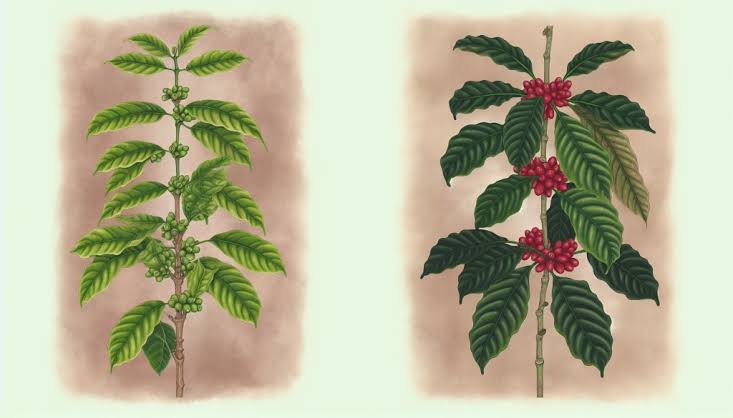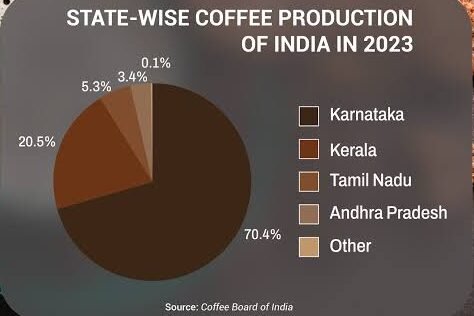India is the sixth-largest producer and fifth-largest exporter of coffee in the world. Indian coffee is grown exclusively under natural shade in humid climates. These shaded plantations create the perfect environment for producing some of the finest coffee flavours with mildness and little acidity. In this article, I’ll discuss India’s top coffee producing states and the effect of different geographical locations on coffee flavour.
In recent years, India has witnessed a remarkable surge in coffee consumption, particularly among the youth. Still, our love for coffee is not a new phenomenon, the iconic South Indian ‘filter coffee’ or ‘kaapi’, brewed with milk and chicory, is a timeless classic, deeply intertwined with there tradition, evoking a sense of culture and nostalgia. Internationally, Kerala’s unique ‘Monsoon Malabar’ coffee has also earned global admiration for its distinctive flavours.
This rising passion for coffee has unlocked a myriad of business opportunities across the country. While some ventures focus on its production, others attract customers through the art of coffee preparation and presentation. Together, these enterprises are not only evolving the coffee culture but also driving economic growth and creating employment opportunities.
There are mainly two types of coffee produced in India, the Arabica and the Robusta coffee, these are grown in different altitudes and result in different flavours.

Arabica v/s Robusta
| CHARACTERISTICS | ARABICA COFFEE | ROBUSTA COFFEE |
| Scientific Name | Coffea arabica | Coffea canephora |
| Altitude Grown | 1,000–2,000 meters | 200–800 meters |
| Climate | Cooler, subtropical climates, temperatures of 15–24°C | Warmer climates, temperatures of 24–30°C |
| Taste Profile | Smooth, mild, and sweet with hints of fruit or sugar. | Strong, bitter, and earthy with a heavier body. |
| Caffeine Content | 1.2–1.5% | 2.2–2.7% |
| Flowering | Requires specific rainfall for flowering and growth. | Tolerates irregular rainfall patterns. |
| Shape of Beans | Oval-shaped with a central curved crease. | Rounder with a straight central crease. |
| Yield | Lower yield, more prone to pests and diseases. | Higher yield, more pest-resistant. |
| Regions Grown in India | Karnataka, Kerala, and Tamil Nadu (primarily in high-altitude regions). | Karnataka, Kerala, Tamil Nadu, Odisha, Andhra Pradesh, and the Northeastern states. |
| Economic Value | Higher price due to better taste and lower supply. | Cheaper, often used in instant coffee and blends. |
| Special Features | Preferred for speciality coffee. | Used in commercial-grade coffee production. |
Coffee Production in India
The history of coffee in India dates back to 1600 A. D. when the Baba Budan planted ‘Seven seeds’ of ‘Mocha’ in his courtyard of hermitage(Chikmagalur), which he had brought from Yemen. After this event, it was cultivated as a backyard plant. In the 17th century, the Dutch introduced its cultivation across the whole country. By the 19th century, the British had commercialized its production and launched its exports to global markets.
Today, the Western and Eastern Ghats are home to India’s major coffee plantations. Karnataka alone contributes to about 71% of total coffee production in India, Kerala up to 21%, and the remaining percentage is contributed by Tamil Nadu, Andhra Pradesh, Odisha and a few north-eastern states. Almost 80% of coffee produced in India is exported and only 20% is consumed domestically.

| Number of Holdings | 250,000 |
| Area (Ha) | 479,000 |
| Production (MT) | 374,200 |
Top Coffee Producing States in India
1. Karnataka: Land of Coffee in India
Chikkamagaluru district, a majestic work of nature in Karnataka is the birthplace of coffee in India. It is located in the foothills of the lush green Mullayanagiri range, which is rich in flora and fauna. If you are one of the coffee lovers then you must have heard of the ‘Café Coffee Day: A chain of youth Coffee hangouts in India’, this celebrated venture owes its origins to the coffee legacy of this remarkable district.
But today, Kodagu district is the major producer of coffee in Karnataka, accounting for 50% of total coffee production in India and about 35% of total production in the country, thanks to its conducive environment for coffee cultivation, which receives a rainfall of 1,000 mm and 5,000 mm per year and a temperature ranging from 18°C to 36°C.
| Number of Holdings | 80,257 |
| Area (Ha) | 2,46,550 |
| Production (MT) | 2,66,885 |
2. Kerala: Birthplace of Monsoon Malabar Coffee.
Kerala receives a mean temperature between 23°C-28°C with adequate rainfall and enough dry spells, which makes it perfect for the production of robusta coffee. One unique feature of coffee production in Kerala is that it varies every year because the small land-holding farmers in Kerala tend to produce coffee to a larger extent and the Keralite planters follow multi-cropping to make optimum use of resources.
Wayanad, Gavi, and Nenmara are the major coffee-producing districts in Kerala and contribute to about 18-21% of coffee in India. Kerala is also home to the renowned ‘Monsoon Malabar Coffee,’ discovered accidentally when coffee beans absorbed moisture during the monsoon, resulting in a unique flavour. Today, Malabar and Konkan follow the same procedure to bring out this amazing taste from nature.
| Number of Holdings | 72,825 |
| Area (Ha) | 85,957 |
| Production (MT) | 72,825 |
3. Tamil Nadu: Home to the finest Arabica Coffee
The Nilgiri Hills of Tamil Nadu are best known for the cultivation of high-quality Arabica Coffee. It is mildly acidic and tends to have a unique floral and citrus flavour, for which it is the best choice in making filter coffee in south India. This filter coffee or Kappi holds deep cultural values in the state. The coffee grown in these hills also emphasises sustainability and eco-friendly practices.
The major coffee-growing districts in Tamil Nadu are Palani Hills, Nilgiri Hills, Coimbatore, and Dindigul, accounting for 5% of total production in the country. But it is the highest coffee-consuming state in India.
| Number of Holdings | 2,31,276 |
| Area (Ha) | 35,685 |
| Production (MT) | 18,435 |
4. Andhra Pradesh: The Organic Coffee State
Andhra Pradesh is a non-traditional coffee-growing state of India, accounting for 12% of total Robusta coffee in the country. Here the coffee is grown in the Chintapalli, Paderu and Maredumilli of Visakhapatnam and East Godavari Districts. The coffee production in the state was initiated by the Britishers in 1898 in Araku Valley to examine its potential in the state.
However, the major production was done under the Andhra Pradesh Forest Development Corporation (APFDC) in the 1960s to wean away the tribals from deforestation as a part of shifting cultivation and providing them employment throughout the year. Today, Araku is one of the ‘World’s Largest Certified Organic Plantations’. However, as per the reports, the productivity in the region is quite low and the number of holdings is high with less than five hectares of land, which is quite concerning in economic terms.
| Number of Holdings | 5,354 |
| Area (Ha) | 80,159 |
| Production (MT) | 15,380 |
5. Odisha: The Emerging Coffee State of India
Currently, the coffee from Odisha is sold under the brand name Koraput Coffee brand. The state government has planned to spend crores in the sector in the next five years. Odisha‘s coffee is known as 100% Arabica coffee indigenous to the state. However, the major Coffee plantation in the state was done in 1954 to arrest the problem of siltation near the Machkund dam in Koraput district. But during that time, no one knew the economic value of this plantation.
Looking at the high potential of the crop in the state, In 2024, the Odisha government has passed the Coffee Plantation for Sustainable Livelihoods (CPSL)’ in six districts, Koraput, Rayagada, Kalahandi, Kandhamal, Keonjhar and Gajapati to multiply the coffee production by ten times. The scheme is yet to be implemented by the Directorate of Soil Conservation and Watershed Development under the Agriculture and Farmers’ Empowerment Department.
| Number of Holdings | 1,00,963 |
| Area (Ha) | 4,868 |
| Production (MT) | 500 |
How to Improve Coffee Production in India?
- Address the Climate Change Impacts: Erratic weather such as unseasonal rainfall, longer drought periods, and inconsistent temperature results in berry loss or degrades the quality of coffee. Coffee production can experience a loss of up to 70% due to these conditions in India. The Research and Development in the field should be appreciated to improve the conditions. A resistant variety or changing the location could be useful in extreme places.
- Prevent Disease and Pest Infestation: Together diseases like Coffee Rust and pests like White Stem Borer or Berry borer can cause a loss of up to 30% in coffee fields. To avoid the infestation, monoculture must be prevented in the states, and appropriate measures should be taken at the right time. Proper distancing and proper sanitation in the field should be strictly done.
- Overcoming Price Factors: The global Coffee prices fluctuate to a great extent in the country, badly impacting the farmers’ income. And the competition with other countries makes the challenge more difficult. The government should help compensate for the losses incurred by the farmers.
- Infrastructure Development: The berry harvesting itself is a tedious task, on top of that poor storage facilities comprise the post-harvest health of the berries. Annually, there is a 60% loss of berries during the post-harvesting activities. A feasible and safe infrastructure including storage, transportation facility and processing unit can reduce the losses to a great extent.
- Unifying the Coffee Producers: The major production of coffee in India is done by small-scale farmers who often lack access to important information related to market and certification. And the produce quality often varies a lot. By unifying the small-scale farmers as one big organisation the dispersal of information will become easier, this way the farmers will be able to enjoy all the benefits like low input cost, storage facilities, shared profits, etc.
Also Read:
Conclusion
Coffee has always been more than just a reflection of Western culture in India; it is deeply rooted in our agricultural heritage. The unique flavours of Indian coffee, much like our spices, are beloved worldwide and the rising global demand for coffee has significantly contributed to strengthening our agricultural economy. Leading coffee-producing states like Karnataka, Kerala, and Tamil Nadu have consistently delivered impressive results.
However, to ensure a prosperous future for coffee cultivation, we must focus on more sustainable production practices and explore the potential for expanding coffee farming to other regions across the country.
Latest Post
- November Issue 2025- Times of Agriculture Magazine
- Punjab & Sind Bank Introduces Special Program to Support Food and Agro-Processing Sector
- Beyond Classrooms and Gardens: How a Professor Turned His Passion into Purpose
- October Issue 2025- Times of Agriculture Magazine
- Top 10 Pesticide Companies in the World
- September Issue 2025- Times of Agriculture Magazine
- Top 15 Fertilizer Companies in the World
- Top 10 Vegetable Farming Profit Per Acre in India
- August 2025 : Times of Agriculture Magazine (AgriVoltaics Farming)
- Button Mushroom Farming: Infrastructure, Cultivation, and Profitability
- Sahiwal Cow: Characteristics, Milk per Day, Price and Origin
- July 2025 : Times of Agriculture Magazine














